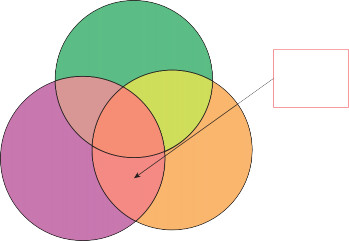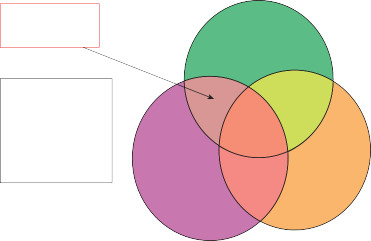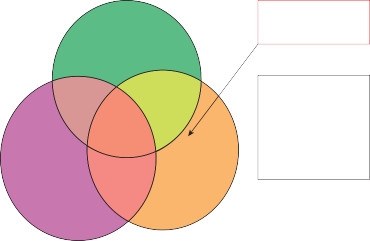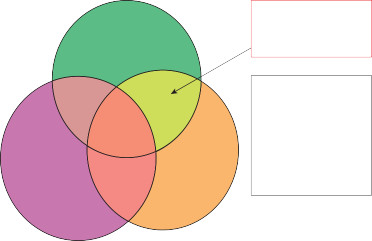Fundamentals of Midwifery: A Textbook for Students (42 page)
Read Fundamentals of Midwifery: A Textbook for Students Online
Authors: Louise Lewis

BOOK: Fundamentals of Midwifery: A Textbook for Students
2.95Mb size Format: txt, pdf, ePub
the woman who provides the ovum for conception (genetic mother), or
the woman who carries the pregnancy to term (gestational mother).Due to surrogacy arrangements and more traditionally, adoption and fostering arrangements
gestational mothers
may be subdivided into one of the following categories:
gestational mothers
may be subdivided into one of the following categories:
A
genetic mother
, who has conceived a child through natural means of sexual intercourse with the genetic father, or through artificial insemination by husband, male partner, or by sperm donor. In partial surrogacy (see Figure 5.6) the genetic mother also acts as the gestational mother who will relinquish the child.
genetic mother
, who has conceived a child through natural means of sexual intercourse with the genetic father, or through artificial insemination by husband, male partner, or by sperm donor. In partial surrogacy (see Figure 5.6) the genetic mother also acts as the gestational mother who will relinquish the child.
A woman who has conceived through in-vitro fertilisation, using donor gametes (oocyte orsperm, or a donor embryo), who intends to be the social mother of this child. Her biological connection to the child is through containing, maintaining and sustaining him or her through pregnancy (see Figure 5.9).
A woman who has conceived through in-vitro fertilisation, using donor gametes (or a donorembryo), who intends to relinquish the child after birth – a
gestational (full) surrogate mother
(see Figure 5.9); her biological connection to the child is also through pregnancy.Those parents who fulfil the nurturing role for the child during pregnancy and beyond, or only after birth can be called the
social parents
(Ber 2000): social parents may have no genetic connection to the child. In a surrogacy arrangement they would be known as the commission- ing parents. A child may have at least one social parent, who may be:A traditional mother is the source of the egg, carries the pregnancy and nurtures the baby after birth, fulfilling genetic, gestational and social rolesTraditionally the relinquishing mother, who gave up her child for adoption, or foster care would fulfil the genetic and gestational mothering roles.
Genetic mother
Social mother
Traditional mother
Gestational mother

 Traditionally an adoptive mother, a stepmother, or a fostermother could also have 97fulfilled the social mothering role.
Traditionally an adoptive mother, a stepmother, or a fostermother could also have 97fulfilled the social mothering role.
Figure 5.5
Venn diagram illustrating the social and biological roles of traditional mothers (Ber 2000; Erin & Harris 1991; FIGO Committee for the Ethical Aspects of Human Reproduction and Women’s Health 2008).Partial or traditional surrogacy is where the gestational mother is the source of the egg and carries the pregnancy, but another social mother nurtures the baby after birth. The baby is genetically related to the surrogate.
 Social mother
Social mother
Traditional (partial) surrogacy
Genetic mother
Traditional mother
Gestational mother
Figure 5.6
Venn diagram illustrating the division of social and biological mothering in traditional surrogacy (Ber 2000; Erin & Harris 1991; FIGO Committee for the Ethical Aspects of Human Reproduction and Women’s Health 2008).In gestational surrogacy the social mother may provide the egg, the gestational mother conceives through in vitro fertilization (IVF) and carries the baby to term. The social mother, who nurtures the child is also genetically related to the baby.
 Gestational
Gestational
 98 surrogacy
98 surrogacy
Social mother
Gestational (full) surrogacy
Social mother = genetic mother≠
gestational mother
Genetic mother
Traditional mother
Gestational mother
 Figure 5.7
Figure 5.7
Venn diagram illustrating the division of social and biological mothering in gestational surrogacy where the social mother is also the genetic mother (Ber 2000; Erin & Harris 1991; FIGO Committee for the Ethical Aspects of Human Reproduction and Women’s Health 2008).A further form of gestational surrogacy is where one woman is the genetic mother, or egg donor, the gestational mother carries the baby to term, and another woman, the commissioning mother, acts as the social mother. There is no genetic relationship between the baby and the social or surrogate mothers.
Social mother
 Gestational surrogacy
Gestational surrogacy
Genetic mother
Traditional mother
Gestational mother
Gestational (full) surrogacy
Social mother ≠ genetic mother≠ gestational mother
Figure 5.8
Venn diagram illustrating the division of social and biological mothering in gestational surrogacy where the social mother is not the genetic mother (Ber 2000; Erin & Harris 1991; FIGO Committee for the Ethical Aspects of Human Reproduction and Women’s Health 2008).A final category is women who conceive using a donor embryo, who are both the gestational mother and the social mother. This is not a surrogacy arrangement.
Social mother

 Conception with donor oocyte orembryo 99
Conception with donor oocyte orembryo 99
Genetic mother
Traditional mother
Gestational mother
Non-surrogacy
donor oocyte/ or embryo, develops in the womb of the gestational mother is also the social mother
Figure 5.9
Venn diagram illustrating the social and gestational mother intersection, when a woman conceives by ovum or embryo donation (Ber 2000; Erin & Harris 1991; FIGO Committee for the Ethical Aspects of Human Reproduction and Women’s Health 2008).
gestational (full) surrogate mother
(see Figure 5.9); her biological connection to the child is also through pregnancy.Those parents who fulfil the nurturing role for the child during pregnancy and beyond, or only after birth can be called the
social parents
(Ber 2000): social parents may have no genetic connection to the child. In a surrogacy arrangement they would be known as the commission- ing parents. A child may have at least one social parent, who may be:A traditional mother is the source of the egg, carries the pregnancy and nurtures the baby after birth, fulfilling genetic, gestational and social rolesTraditionally the relinquishing mother, who gave up her child for adoption, or foster care would fulfil the genetic and gestational mothering roles.
Genetic mother
Social mother
Traditional mother
Gestational mother

 Traditionally an adoptive mother, a stepmother, or a fostermother could also have 97fulfilled the social mothering role.
Traditionally an adoptive mother, a stepmother, or a fostermother could also have 97fulfilled the social mothering role.Figure 5.5
Venn diagram illustrating the social and biological roles of traditional mothers (Ber 2000; Erin & Harris 1991; FIGO Committee for the Ethical Aspects of Human Reproduction and Women’s Health 2008).Partial or traditional surrogacy is where the gestational mother is the source of the egg and carries the pregnancy, but another social mother nurtures the baby after birth. The baby is genetically related to the surrogate.
 Social mother
Social motherTraditional (partial) surrogacy
Genetic mother
Traditional mother
Gestational mother
Figure 5.6
Venn diagram illustrating the division of social and biological mothering in traditional surrogacy (Ber 2000; Erin & Harris 1991; FIGO Committee for the Ethical Aspects of Human Reproduction and Women’s Health 2008).In gestational surrogacy the social mother may provide the egg, the gestational mother conceives through in vitro fertilization (IVF) and carries the baby to term. The social mother, who nurtures the child is also genetically related to the baby.
 Gestational
Gestational 98 surrogacy
98 surrogacySocial mother
Gestational (full) surrogacy
Social mother = genetic mother≠
gestational mother
Genetic mother
Traditional mother
Gestational mother
 Figure 5.7
Figure 5.7Venn diagram illustrating the division of social and biological mothering in gestational surrogacy where the social mother is also the genetic mother (Ber 2000; Erin & Harris 1991; FIGO Committee for the Ethical Aspects of Human Reproduction and Women’s Health 2008).A further form of gestational surrogacy is where one woman is the genetic mother, or egg donor, the gestational mother carries the baby to term, and another woman, the commissioning mother, acts as the social mother. There is no genetic relationship between the baby and the social or surrogate mothers.
Social mother
 Gestational surrogacy
Gestational surrogacyGenetic mother
Traditional mother
Gestational mother
Gestational (full) surrogacy
Social mother ≠ genetic mother≠ gestational mother
Figure 5.8
Venn diagram illustrating the division of social and biological mothering in gestational surrogacy where the social mother is not the genetic mother (Ber 2000; Erin & Harris 1991; FIGO Committee for the Ethical Aspects of Human Reproduction and Women’s Health 2008).A final category is women who conceive using a donor embryo, who are both the gestational mother and the social mother. This is not a surrogacy arrangement.
Social mother

 Conception with donor oocyte orembryo 99
Conception with donor oocyte orembryo 99Genetic mother
Traditional mother
Gestational mother
Non-surrogacy
donor oocyte/ or embryo, develops in the womb of the gestational mother is also the social mother
Figure 5.9
Venn diagram illustrating the social and gestational mother intersection, when a woman conceives by ovum or embryo donation (Ber 2000; Erin & Harris 1991; FIGO Committee for the Ethical Aspects of Human Reproduction and Women’s Health 2008).
a
social mother
(see Figure 5.5)
social mother
(see Figure 5.5)
a
social father
(see Figure 5.10).A child may also legally have two social parents of the same gender (Griffith 2010). A social mother may be:
social father
(see Figure 5.10).A child may also legally have two social parents of the same gender (Griffith 2010). A social mother may be:
Other books
The Rancher's Untamed Heart by Nicole Jordan
The Dream Thieves by Stiefvater, Maggie
The Brothel Creeper: Stories of Sexual and Spiritual Tension by Rhys Hughes
The Revenge of the Elves by Gary Alan Wassner
OBSESSED WITH MY STEP (TABOO NOVELLA) by Zania Summers
The Front Runner by Patricia Nell Warren
Picture Perfect by Catherine Clark
Shadows Have Gone by Lissa Bryan
Bella by Jilly Cooper